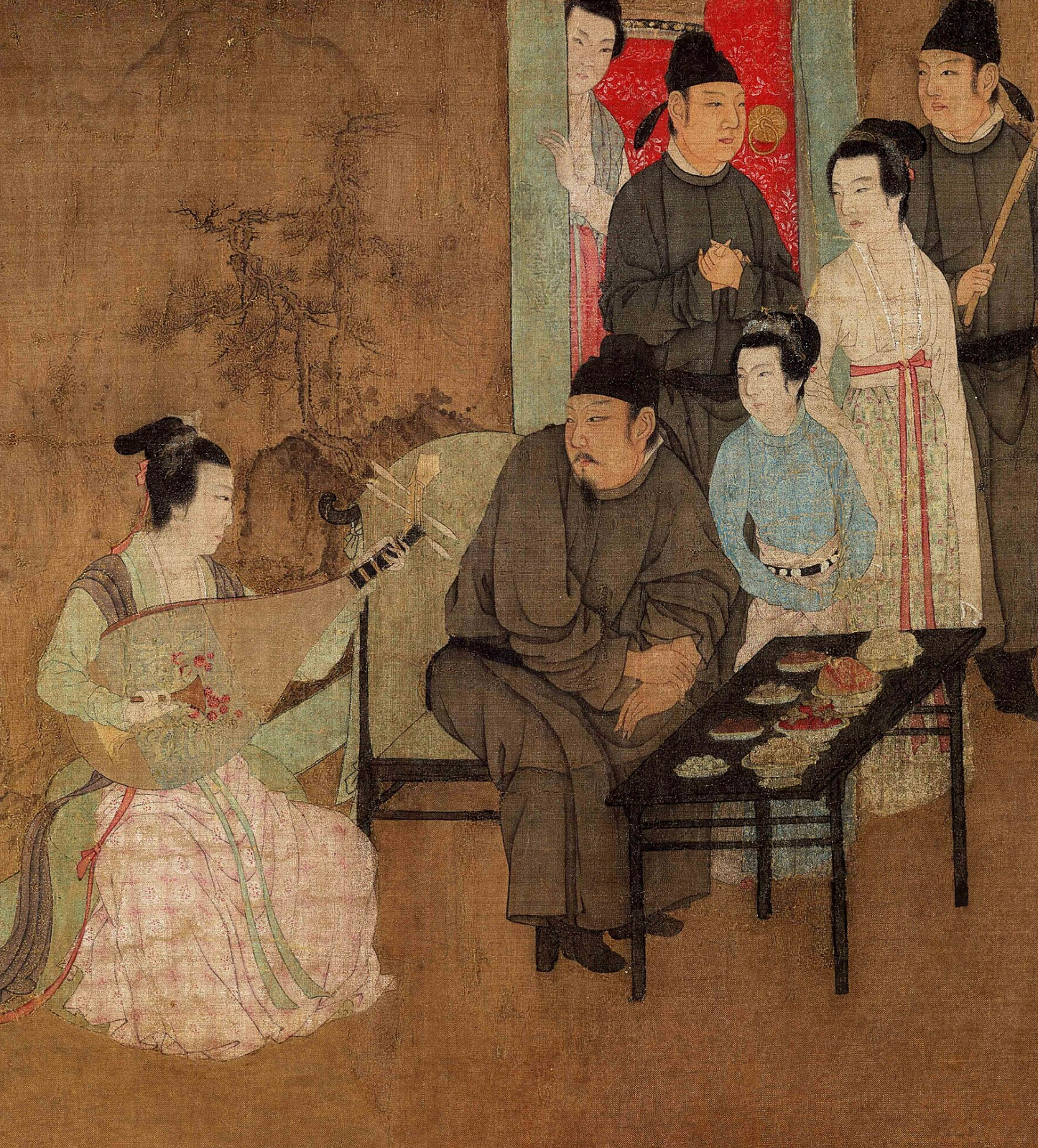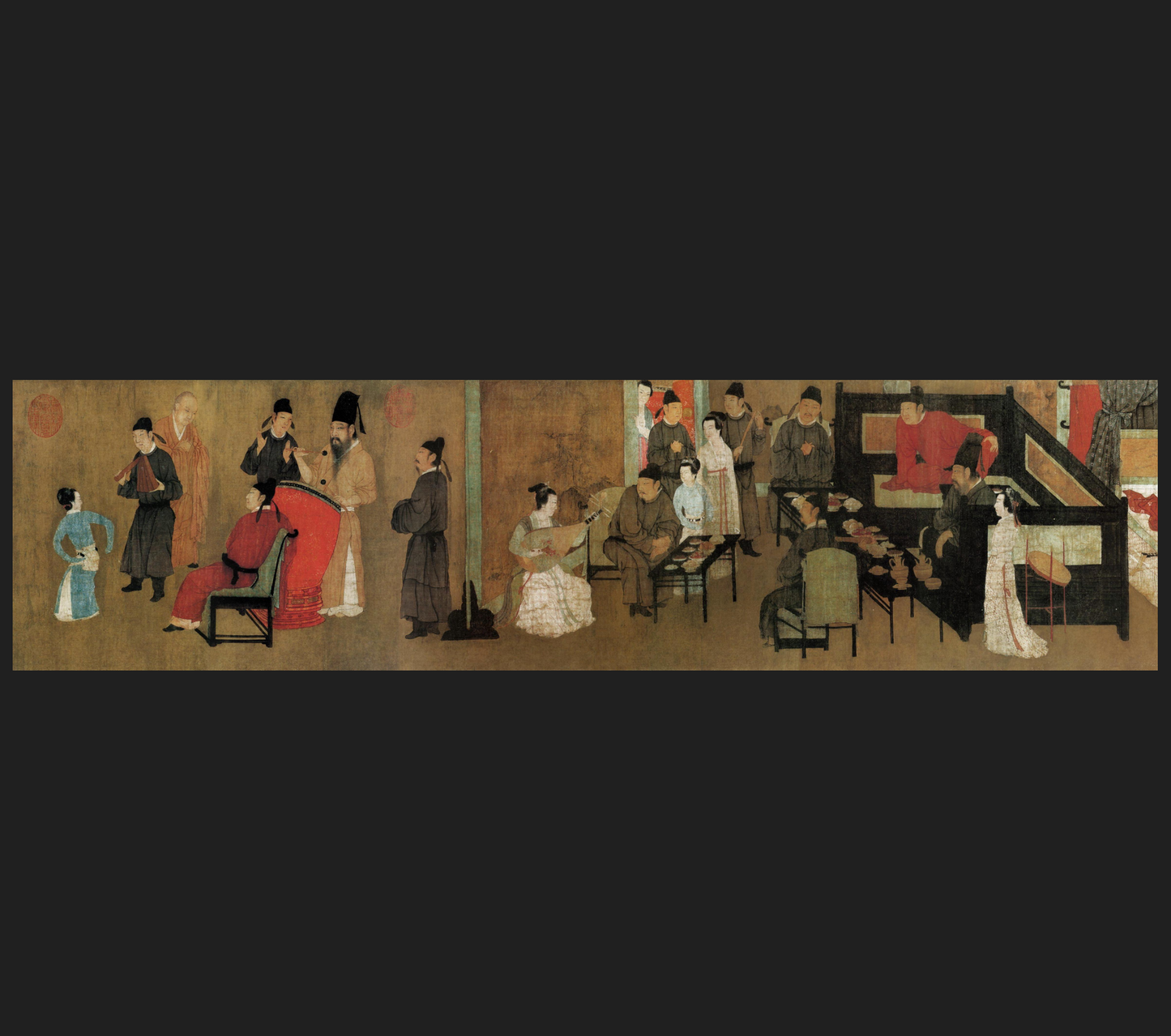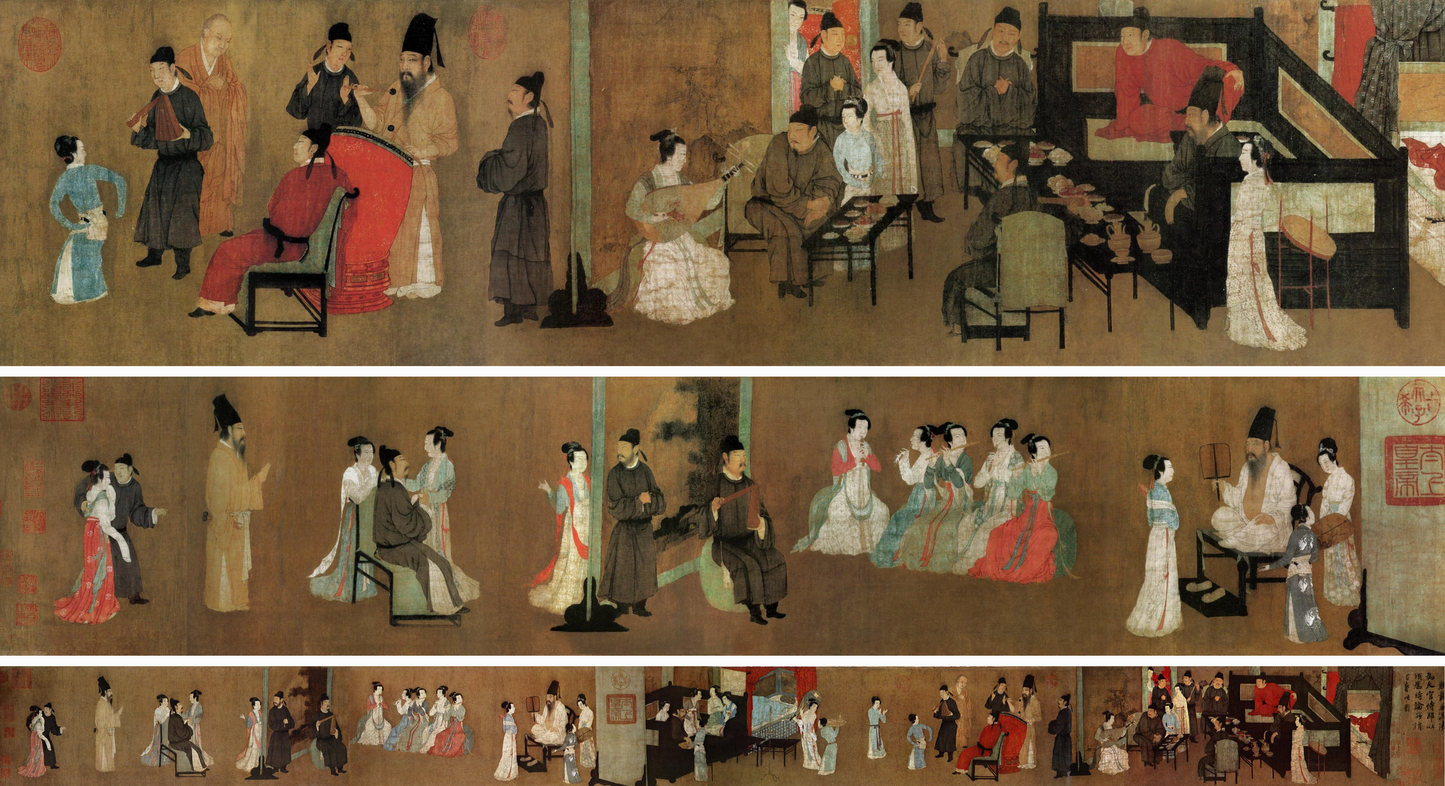韩熙载夜宴图卷
The Night Revels of Han Xizai
The Night Revels of Han Xizai
Couldn't load pickup availability
Share
Gu Hongzhong's "The Night Revels of Han Xizai" - A High-Quality Reproduction of an Ancient Chinese Masterpiece
This exquisite artwork vividly recreates a historic night banquet hosted by Han Xizai, a prominent minister of the Southern Tang Dynasty. It captures the lively atmosphere of the gathering, featuring music, dance, and the mingling of guests, while also revealing the complex personality of Han Xizai, who appears both carefree and melancholic. The painting is divided into five sections, each depicting a different moment of the evening:
Listening to Music: Han Xizai and Lang Can, the top scholar, sit on a couch, engrossed in the pipa performance by the sister of Li Jiaming, the deputy director of the Imperial Music Bureau. Other guests, including Zhu Xian, Chen Zhiyong, Shu Ya, and the courtesan Wang Wushan, are also present.
Watching the Dance: The guests enjoy Wang Wushan's graceful "Liuyao Dance," with Han Xizai enthusiastically playing the "Jiegu" drum. The monk Deming unexpectedly encounters the scene, standing awkwardly with his back turned and hands clasped.
Taking a Break: Han Xizai rests on a bed with his courtesans, washing his hands.
Enjoying the Flute Performance: Han Xizai sits casually on a chair, enjoying a flute ensemble performed by five female musicians.
End of the Banquet: Han Xizai bids farewell to his guests with a drumstick in hand, while some guests linger, flirting with the courtesans.
The painting is presented in a连环画 (comic strip) style, with each section separated by screens or panels, yet seamlessly connected to form a cohesive and dynamic narrative. The composition masterfully balances tension and relaxation, with characters portrayed in vivid detail. For example, Lang Can leans forward attentively, Li Jiaming gazes affectionately at his sister, and the guests clap spontaneously. In the dance scene, Wang Wushan's delicate figure and Deming's awkward posture are rendered with remarkable expressiveness.
The most striking portrayal is that of Han Xizai himself. His long beard and tall hat match historical descriptions, while his gestures and expressions reveal his complex inner world. On one hand, he appears unrestrained and indulgent, personally drumming for Wang Wushan, lounging casually while listening to music, and allowing guests to mingle freely with courtesans. On the other hand, he seems distracted and melancholic, his gaze fixed and unsmiling while drumming, and his absent-mindedness during the flute performance, chatting idly with a maid. These details expose his disillusionment in later years and his attempt to drown his sorrows in wine and pleasure.
The artist not only captures Han Xizai's physical likeness with portrait-like precision but also delves deeply into his psyche, presenting a multidimensional character that authentically reflects the historical figure.
The artistic quality of the work is exceptional. The forms are precise and detailed, the lines are smooth and refined, and the colors are vibrant yet elegant. The use of ink and brushwork varies skillfully across different elements, and the coloring is rich and harmonious. The contrast between the courtesans' delicate attire and the male guests' dark robes is striking, while the deep black furniture adds a sense of antiquity and gravitas. The patterns on the courtesans' dresses, curtains, and bedding are intricate and colorful, creating a sophisticated and elegant aesthetic.
This reproduction is based on a Southern Song Dynasty copy (1163–1224) of the original Tang Dynasty masterpiece. It reflects the original's style and artistic excellence, making it a treasured piece of ancient Chinese art with a well-documented history. Perfect for collectors and art enthusiasts, this painting offers a glimpse into the rich cultural heritage of China.
顾闳中韩熙载夜宴图卷古画真迹高清复制
作品如实地再现了南唐大臣韩熙载夜宴宾客的历史情景,细致地描绘了宴会上弹丝吹竹、清歌艳舞、主客揉杂、调笑欢乐的热闹场面,又深入地刻划了主人公超脱不羁、沉郁寡欢的复杂性格。全图共分为五个段落,首段“听乐”,韩熙载与状元郎粲坐床榻上,正倾听教坊副使李家明之妹弹琵琶,旁坐其兄,在场听乐宾客还有紫微朱铣、太常博士陈致雍、门生舒雅、家伎王屋山诸人;二段“观舞”,众人正在观看王屋山跳“六幺舞”,韩熙载亲擂“羯鼓”助兴,好友德明和尚不期而遇此景,尴尬地拱手背立;三段“暂歇”,韩熙载与家伎们坐床上休息,韩正在净手;四段“清吹”,韩熙载解衣盘坐椅上,欣赏着五个歌女合奏;五段“散宴”,韩氏手持鼓槌送别,尚有客人在与女伎调笑。全卷以连环画的形式表现各个情节,每段以屏风隔扇加以分隔,又巧妙地相互联结,场景显得统一完整。布局有起有伏,情节有张有弛,尤其人物神态刻画栩栩如生,如“听乐”段状元郎粲的倾身细听动姿、李家明关注其妹的亲切目光、他人不由自主的合手和拍;“观舞”段王屋山娇小玲珑的身姿、德明和尚背身合掌低首而立的尴尬状等等,传尽心曲,入木三分。最出色的还是主人公韩熙载的刻画,长髯、高帽的外形与文献记载均相吻合,举止、表情更显露出他复杂的内心。一方面,他在宴会上与宾客觥筹交错,不拘小节,如亲自击鼓为王屋山伴奏,敞胸露怀听女乐合奏,送别时任客人与家伎厮混,充分反映了他狂放不羁、纵情声色的处世态度和生活追求;另一方面又心不在焉、满怀忧郁,如擂鼓时双目凝视、面不露笑,听清吹时漫不经心,与对面侍女闲谈,这些情绪都揭示了他晚年失意、以酒色自汙的心态。画家塑造的韩熙载,不仅形象逼肖,具肖像画性质,而且对其内心挖掘深刻,性格立体化,可以说真实再现了这位历史人物的原貌。
作品的艺术水平也相当高超。造型准确精微,线条工细流畅,色彩绚丽清雅。不同物象的笔墨运用又富有变化,尤其敷色更见丰富、和谐,仕女的素妆艳服与男宾的青黑色衣衫形成鲜明对照。几案坐榻等深黑色家具沉厚古雅,仕女裙衫、帘幕、帐幔、枕席上的图案又绚烂多采。不同色彩对比参差,交相辉映,使整体色调艳而不俗,绚中出素,呈现出高雅、素馨的格调。
历代著录的顾闳中《韩熙载夜宴图》有数本,此卷据各方面考证,当属南宋孝宗至宁宗朝(1163—1224年)摹本,其风格基本反映出原作面貌,且达到相当高水平,堪称流传有绪的古代绘画珍品。






